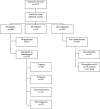The prevalence and risk factors of overactive bladder symptoms and its relation to pelvic organ prolapse symptoms in a general female population
- PMID: 21104400
- PMCID: PMC3072516
- DOI: 10.1007/s00192-010-1323-x
The prevalence and risk factors of overactive bladder symptoms and its relation to pelvic organ prolapse symptoms in a general female population
Abstract
Introduction and hypothesis: To study the prevalence and risk factors of overactive bladder (OAB) symptoms and its relationship with symptoms of pelvic organ prolapse (POP).
Methods: This is a cross-sectional study including women aged between 45 and 85 years, registered in eight general practices. All women were asked to self complete the validated Dutch translated questionnaires. All symptoms were dichotomized as present or absent based on responses to each symptom and degree of bother.
Results: Forty-seven percent of the women filled out the questionnaire. Prevalence of urgency was 34% and the prevalence of any OAB symptoms 49%. Prevalence of OAB symptoms increased with advancing age. Symptoms of POP were an independent risk factor for symptomatic OAB. Other risk factors were continence and prolapse surgery in the past, age above 75, overweight, postmenopausal status and smoking.
Conclusions: The prevalence of any OAB symptoms was 49%. POP symptoms were an independent risk factor for symptomatic OAB.
Figures
References
-
- Abrams P, Cardozo L, Fall M, Griffiths D, Rosier P, Ulmsten U, van KP, Victor A, Wein A. The standardisation of terminology of lower urinary tract function: report from the Standardisation Sub-committee of the International Continence Society. Neurourol Urodyn. 2002;21(2):167–178. doi: 10.1002/nau.10052. - DOI - PubMed
MeSH terms
LinkOut - more resources
Full Text Sources
Medical
Miscellaneous



